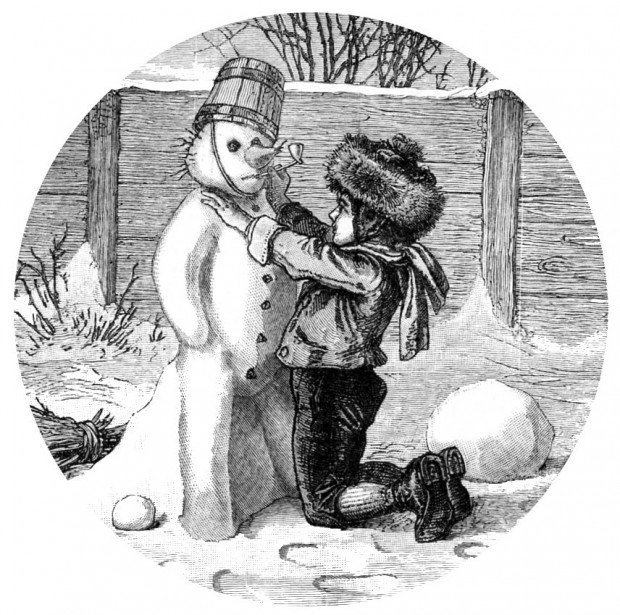THE SCOTTISH BONNET
As I look out the window and study a crow’s orange beak, I am shown a vision of a snowman created by a child. The nose is the tip of a carrot, the eyes are made of buttons and the lips are radish sticks. He has a Scottish bonnet on the top of his head, a woollen plaid scarf around his neck, and he is being pulled away on a sled by a young boy.
When I step back from the image, it looks like a Norman Rockwell or Currier and Ives print. A typical winter scene in a typical American town. The boy looks like many boys his age, and the snowman is not that different from many others that have been created before him. What is extraordinary, however, is that this one is being taken away somewhere. As I watch them leave the driveway of the boy’s home, I expect to see the boy turn onto the sidewalk, but instead, I see him pull the sled out into the middle of the street itself and head in the direction of town. For a few seconds, it’s just the boy and the snowman, but very soon cars start coming up from behind. They are also heading to town but can’t pass him because he is walking right down the middle and refuses to move over for them. They begin to honk loudly and are soon rolling down windows and yelling at him. But the young boy doesn’t appear to be bothered by all the commotion behind him. He just keeps walking at the same pace, looking straight ahead with a fierce determination. He has a goal in mind and a destination planned, and he will not go off course just to accommodate others.
In no time at all, it looks as if half the town is behind him, irate and up in arms over his inconsideration. Word has somehow gotten out by now, and people are coming out of their houses and watching the boy parade through the neighborhood. Some recognize him as the Johnson boy who left school early last year and is now being home schooled by his mother. “A creative genius” is what one teacher said about him while others described him as a strange one who didn’t play well with the other kids.
Eventually, the boy turns off the main street and onto an alleyway, finally freeing all the cars that were backed up behind him. After passing a few houses, he quickly turns left onto a dirt path and heads toward an abandoned barn out in the middle of a corn field. He disappears from sight for a few minutes as he maneuvers the sled around the cornstalks and then suddenly emerges right in front of the barn door. He looks down on the ground at a small rock next to him, then bends down and pulls out a key hidden underneath. When he opens the padlock and slides the door back, the most amazing scene is revealed. Row after row of snowmen identical to the one he has been hauling on his sled, the only differences between them are the hats on their heads and the scarves around their necks.
One row has American baseball caps on, some with black scarves, some with red, some with green, some with yellow and some with metallic gold. Another row has Russian Cossack fur hats on with a similar assortment of different colored scarves. There is also a row of Chinese peasant paddy hats, a row of Muslim prayer caps, and a row of Bavarian style mountain hats with a feather on the side. Each row of snowmen seems to represent a different nationality or religion, and each scarf a different personality or ideology. As one looks closer, it is then apparent that the button eyes on each row are also different. Some are large and fully round, while others are much smaller, some partially closed and some squinting. The noses all look the same, though, and the mouths more or less, only some of the lips look fuller. But despite their festive hats and colorful scarves, these are not joyful looking snowmen. They are too lifeless and robotic looking to represent a magical winter wonderland or to entertain and amuse children. Row after row of these snowmen that stand too stiff and too close together, like the Terracotta soldiers who guarded their Emperor.
Off to the side, in a dark corner, sits the Johnson boy in front of a computer. There is one small light aimed at his desk drawer, and he is searching wildly for something hidden in the back. He keeps reaching all over with his hands but can’t find what he is looking for. After an extensive search, he eventually gives up and begins to type on the keyboard again, trying yet another password. When an error message comes up and he is permanently locked out, he puts his head down on the counter, pounds his fists, and begins to cry.
Copyright © 2015 (Michelle Parsons, Getting Back on Your Path). All Rights Reserved.

